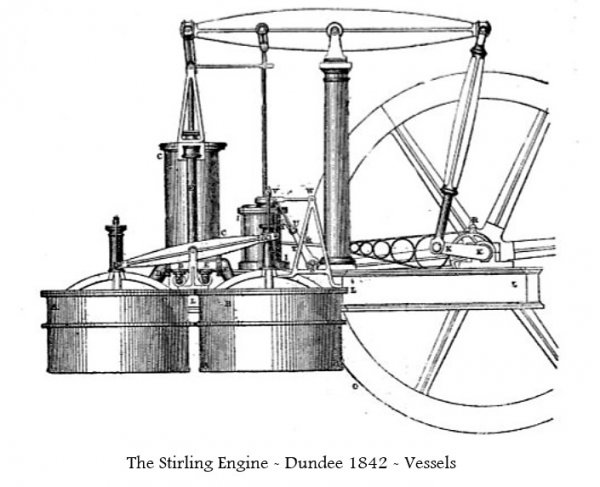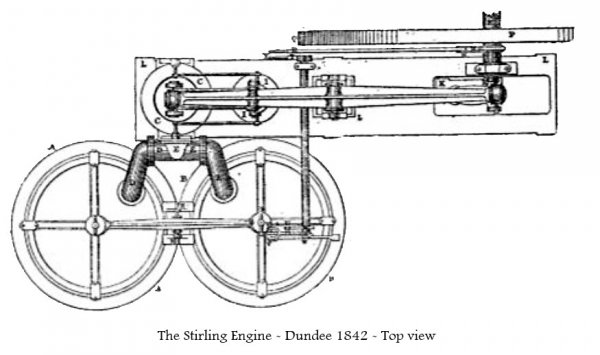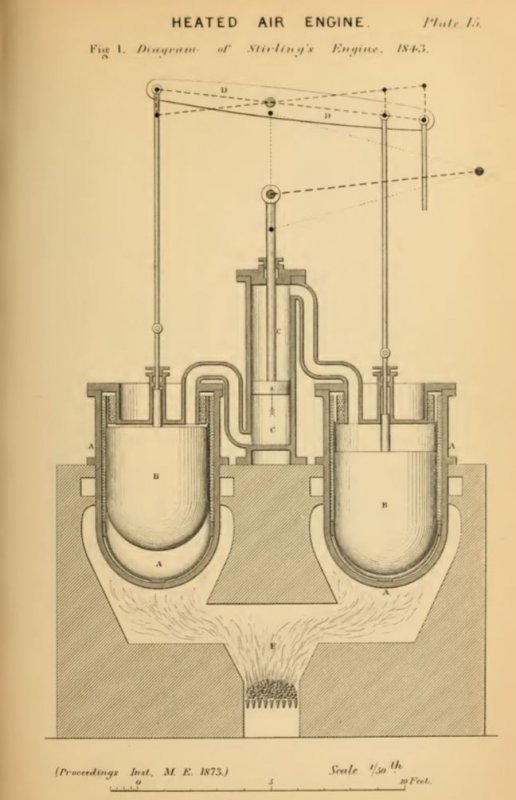The Dundee Engine of 1842
Before the Stirlings did a practival engine with their 1827 patent, it took years. The new concept was to use compressed air in order to get more power out of the engine.
But it took again a new patent, filed by Robert Stirling and his brother James Stirling Oct. 1, 1841 (patent 8652), for improvements about the 1827 engine.
At last this one gave birth to a beautiful engine.
James Stirling built an engine based on the 1827 and 1841 patants, in a foundry in Dundee, Scotland, in room of a steam engine, where it worked for almost three years.
This Dundee engine is at the origin of Stirling's great reputation.
The Stirling engine of 1842 used the same working principle as the previous ones, and is the result of years of work and improvements. Stirling's economiser (later called regenerator) plays their a crucial role.
Nonetheless it is unsure whether this Stirling engine is the result of Stirling alone. Knight says "the engine seems to have been essentially a duplication of the invention of Parkinson and Crossley.
This stunning Stirling engine will be presented as follow:
- With the help of the Stirling patent of 1840
- A paper from Scientific American written later in 1861 that gives a well overall description
- This paper is followed by a discussion
- A presentation made by James Stirling himself, read before the Institution of Civil Engineers en 1845.
- Also followed by a discussion
- Testimonies about the Stirling engine malfunction
A diagram of Stirling's engine is given in the above figure. The two heating vessels A A have their lower ends exposed to the fire F, their upper ends being kept cool by means of water circulating round them. They contain the two plungers or displacers B B, attached to the opposite ends of a horizontal beam D, which is oscillated by a crank and connecting rod from the main shaft of the engine ; these displacers do not fit the heating vessels, but have an annular space left all round them. The working cylinder C, containing a close-fitting piston, communicates at top with one of the heating vessels, and at bottom with the other.
By the alternate upward and downward movement of the plungers B B the air in the heating vessels is displaced, and sent alternately to the bottom or heated part and to the top or cool part of the vessels ; the air in either vessel thus becomes heated or cooled according as the plunger is respectively at the top or bottom of its stroke. A difference of pressure must therefore take place in the spaces above and below the working piston, which will consequently move in the direction of the lower pressure ; and in doing so it changes the position of the plungers, and the operation is reversed.
A Regenerator, or more correctly speaking a Respirator, was employed for utilising that portion of the heat which would otherwise have been thrown away with the exhaust air; and this was the special invention of Dr. Robert Stirling. The regenerator consisted of a passage or chamber, filled in some instances with thin metallic plates or gratings, in some with copper wire or gauze, and in others with thin metallic tubes.
Through this chamber the exhaust air was made to pass, and while traversing the interstices it deposited there a portion of its heat ; the cold air subsequently introduced, traversing the regenerator in the opposite direction, took up the heat left in the metal. By this means the heat that would otherwise have been thrown away in the exhaust air was utilised for increasing the temperature of the incoming supply of air.
Two of these improved engines were constructed, one with a cylinder 12 inches in diameter and 2 feet stroke, which made 40 revolutions per minute and worked up to 21 horse power, consuming 2.5 lbs. of coal per indicated horse power per hour; and another in 1843 with a cylinder 16 inches in diameter and 4 feet stroke, making 28 revolutions per minute and giving 45 horse power.
The latter was the celebrated engine of the Dundee Foundry, and did all the work of that establishment for upwards of three years, during which period no other motive power was employed. It was laid aside however at the end of that time owing to the failure of the heating vessels, which could not stand the heat they were exposed to.


